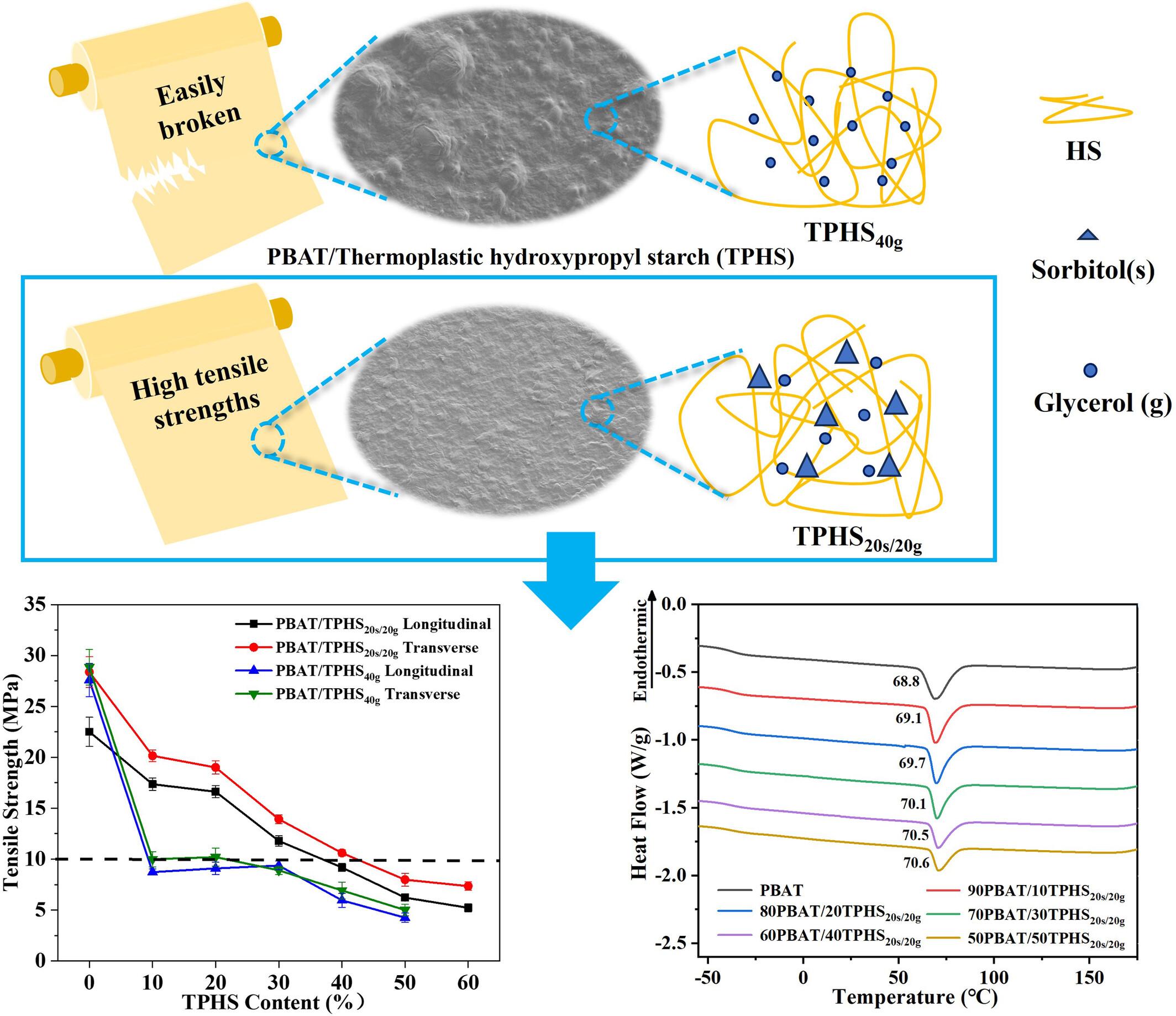求助PDF
{"title":"Preparation and properties of poly[(butylene adipate)-co-terephthalate]/thermoplastic hydroxypropyl starch films","authors":"Muxi Wang, Zehao Li, Wenbo Zhao, Zhenyu Huang, Hong Liu, Li-Jun Ma, Liting Yang","doi":"10.1002/pi.6645","DOIUrl":null,"url":null,"abstract":"<p>Poly[(butylene adipate)-<i>co</i>-terephthalate] (PBAT) is currently the most widely used and versatile petroleum-based fully biodegradable polyester, drawing extensive attention from researchers. However, the high production cost of PBAT restricts its widespread application. Currently, incorporating fillers into PBAT materials is considered the most effective approach to reduce production costs, with thermoplastic starch recognized as the optimal filler for PBAT base materials. Nevertheless, the low mechanical strength of thermoplastic starch significantly compromises the performance of PBAT base materials. In this study, thermoplastic starch with higher mechanical strength was prepared by partially substituting commonly used glycerol with a higher molecular weight sorbitol as the plasticizer. The enhanced thermoplastic starch was then used as a filler for PBAT materials, leading to the fabrication of PBAT-based blend films with high starch content. Mechanical property tests revealed a 52.2% and 65.3% increase of tensile strength in the transverse and longitudinal directions, respectively, when sorbitol partially replaced glycerol as the plasticizer for thermoplastic starch. Scanning electron microscopy results demonstrated improved dispersion of thermoplastic starch particles in PBAT when sorbitol and glycerol were used together. Meanwhile, the thermal performance and stability of PBAT were not significantly affected by the thermoplastic starch filling. © 2024 Society of Chemical Industry.</p>","PeriodicalId":20404,"journal":{"name":"Polymer International","volume":"73 9","pages":"761-769"},"PeriodicalIF":3.6000,"publicationDate":"2024-04-25","publicationTypes":"Journal Article","fieldsOfStudy":null,"isOpenAccess":false,"openAccessPdf":"","citationCount":"0","resultStr":null,"platform":"Semanticscholar","paperid":null,"PeriodicalName":"Polymer International","FirstCategoryId":"92","ListUrlMain":"https://onlinelibrary.wiley.com/doi/10.1002/pi.6645","RegionNum":4,"RegionCategory":"化学","ArticlePicture":[],"TitleCN":null,"AbstractTextCN":null,"PMCID":null,"EPubDate":"","PubModel":"","JCR":"Q2","JCRName":"POLYMER SCIENCE","Score":null,"Total":0}
引用次数: 0
引用
批量引用
Abstract
Poly[(butylene adipate)-co -terephthalate] (PBAT) is currently the most widely used and versatile petroleum-based fully biodegradable polyester, drawing extensive attention from researchers. However, the high production cost of PBAT restricts its widespread application. Currently, incorporating fillers into PBAT materials is considered the most effective approach to reduce production costs, with thermoplastic starch recognized as the optimal filler for PBAT base materials. Nevertheless, the low mechanical strength of thermoplastic starch significantly compromises the performance of PBAT base materials. In this study, thermoplastic starch with higher mechanical strength was prepared by partially substituting commonly used glycerol with a higher molecular weight sorbitol as the plasticizer. The enhanced thermoplastic starch was then used as a filler for PBAT materials, leading to the fabrication of PBAT-based blend films with high starch content. Mechanical property tests revealed a 52.2% and 65.3% increase of tensile strength in the transverse and longitudinal directions, respectively, when sorbitol partially replaced glycerol as the plasticizer for thermoplastic starch. Scanning electron microscopy results demonstrated improved dispersion of thermoplastic starch particles in PBAT when sorbitol and glycerol were used together. Meanwhile, the thermal performance and stability of PBAT were not significantly affected by the thermoplastic starch filling. © 2024 Society of Chemical Industry.
聚(己二酸丁二醇酯-对苯二甲酸丁二醇酯)/热塑性羟丙基淀粉薄膜的制备与性能
聚对苯二甲酸丁二醇酯(PBAT)是目前应用最广泛、用途最广的石油基全生物降解聚酯,受到研究人员的广泛关注。然而,PBAT 的生产成本较高,限制了其广泛应用。目前,在 PBAT 材料中加入填料被认为是降低生产成本的最有效方法,而热塑性淀粉被认为是 PBAT 基础材料的最佳填料。然而,热塑性淀粉的机械强度较低,严重影响了 PBAT 基础材料的性能。在本研究中,通过用分子量更高的山梨醇部分替代常用的甘油作为增塑剂,制备出了机械强度更高的热塑性淀粉。增强后的热塑性淀粉被用作 PBAT 材料的填料,从而制成了高淀粉含量的 PBAT 基混合薄膜。机械性能测试表明,当山梨醇部分取代甘油作为热塑性淀粉的增塑剂时,横向和纵向的拉伸强度分别提高了 52.2% 和 65.3%。扫描电子显微镜结果表明,当山梨醇和甘油同时使用时,热塑性淀粉颗粒在 PBAT 中的分散性得到改善。同时,热塑性淀粉填充物对 PBAT 的热性能和稳定性影响不大。本文受版权保护,未经许可不得转载。
本文章由计算机程序翻译,如有差异,请以英文原文为准。


 求助内容:
求助内容: 应助结果提醒方式:
应助结果提醒方式:


